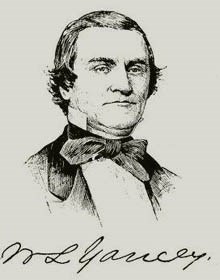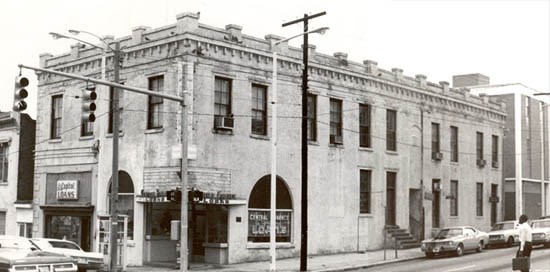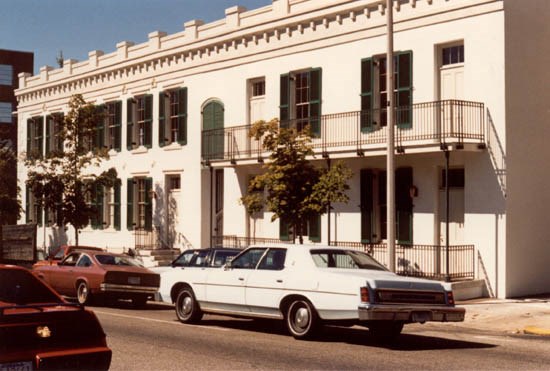
NPS Photo
William Lowndes Yancey Law Office
Montgomery, AL
Designated an NHL: November 7, 1973
Designation withdrawn: March 5, 1986
William Lowndes Yancey, an important figure in antebellum sectional politics, had his law office in this building from 1846 until his death in 1863. During this period Yancey gained national political influence as an aggressive advocate of states' rights, helped to unite Southerners behind this cause, and exacerbated sectional differences that led to the secession of the Southern states from the Union.
Yancey began his political career in 1840, having previously been a lawyer, editor and cotton planter. He served in both the lower and upper houses of the Alabama legislature. Yancey advocated populist causes such as reform of the banks and the penal system, establishment of a state penitentiary, legal rights for married women, a free public school system, and very significantly, state legislature representation apportioned on the basis of the white population only. This latter position sets Yancey apart from the planter class advocates and places him among the mass of yeoman agrarians. He described his stance: "I attempt to represent the great mass of the people versus the aristocracy."
Yancey served in Congress from December 2, 1844 until September 1, 1846. His oratorical talents made him the center of attention, but he despaired of the rampant partisan and sectional conflicts of the government. He resigned by a letter to his party impeaching its integrity and condemning its weakening defense of southern rights. Settling near Montgomery, Yancey went into the legal profession with John A. Elmore, a partnership which was destined to become a distinguished firm.
It was Yancey's intent to shift his defense of southern rights from the halls of Congress to the public forum from which, he believed, future political leadership would spring. The Wilmot Proviso, which would have prohibited slavery in the territories acquired from Mexico, gave Yancey his first opportunity to act. He quickly became the leader of Alabama states' rights forces and adroitly controlled the state convention in 1847 by unifying the delegates in opposition to the Wilmot Proviso. The following year the Democratic delegation to the national convention committed itself against the Proviso, against squatter sovereignty and against any candidate who would not repudiate it. The principles of opposition to the Wilmot Proviso, known as the "Alabama Platform," were a significant foreshadowing of the radical sectionalism which would pull the nation apart. The "Alabama Platform" was designed to curb the will of the majority and preserve to the states all powers not expressly granted to the federal government, equal rights of citizens and states in the territories, and the duty of Congress to protect property rights therein so long as they remained territories. The platform was endorsed in legislatures and conventions throughout the South.

NPS Photo
The next twelve years were ones of intense political organization for Yancey. He launched his campaign to unify the South into one great sectional party. The first line in this campaign was the organization of Southern rights associations, non-partisan groups drawn from the major parties. In 1858 this drive culminated in the emergence of the League of United Southerners. The second approach was through the hustings. Yancey's brilliant oratory reached thousands at banquets, barbecues, receptions, and parties. The third line of attack was exposed in his speech in Columbia, South Carolina in 1859. There he concluded that in the next year if Southern rights were not protected in the convention, a grand Southern party should be created and if a Republican were elected then separation should be accomplished before he took office.
In the state convention of 1860, the Alabama Platform was again endorsed and the delegates instructed to walk out if the Democrats at the national convention in Charleston rejected it. At Charleston, after a brilliant confrontation between Yancey and George E. Pugh, spokesman for the Northern delegates, the convention only partly endorsed the Yancey position. Unsatisfied, Yancey's contingent walked out and in so doing, destroyed the party. When Yancey's delegation was refused a seat at the reassembled convention in Baltimore, additional delegates withdrew and joined Yancey to create the Constitutional Democratic Party which then nominated Breckinridge for president. It was Yancey's party and at its helm he traveled from Boston to New Orleans delivering over one hundred addresses in its defense. Following Lincoln's election, he dominated the proceedings of the pivotal Alabama convention and wrote the state's Ordinance of Secession. Yancey served in the Confederacy as Commissioner to England and France. Retiring in 1862, he was elected to the Senate of the Confederacy and served in that body until his death in 1863.

NPS Photo
The William Lowndes Yancey Law Office was designated a National Historic Landmark on November 7, 1973 for its association with Yancey and his significant role in sectional politics that led to the secession of the Southern states. At the time of its designation, the exterior retained much of its historic integrity. The interior retained elements of the historic floor plan, interior finish, and features such as mantels and bookshelves, believed to reflect historic uses. In the late 1970s, however, structural problems in the building as well as the owner's desire to develop the property, led to the removal of much of the building's interior fabric including features that reflected the building's historic use as office space. On the exterior, deteriorated masonry was replaced with new materials.
Under a new owner, a restoration of the building was undertaken in the 1980s; this work received certification that it met the Secretary of the Interior's Standards for Rehabilitation. The work done by the previous owner of the building, however, led to the conclusion that the building had lost the qualities which caused it to be designated originally. After restoration, sections of the original building fabric remained (the foundations, major portions of exterior walls, the roof structure, and the interior walls in the eastern section of building) but substantial losses had occurred since designation of the property in 1973. In particular, the interior alterations compromised its integrity as historic office space. Those features associated with its historic use as an office did not survive. The Landmark designation of the William Lowndes Yancey Law Office was withdrawn on March 5, 1986. The property was retained on the National Register of Historic Places, however, as it still met the criteria of that program.
Last updated: August 29, 2018
